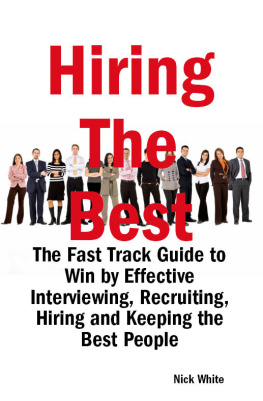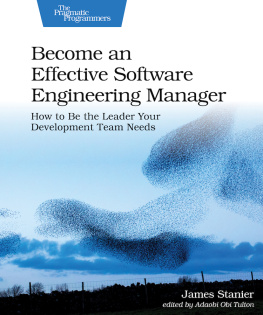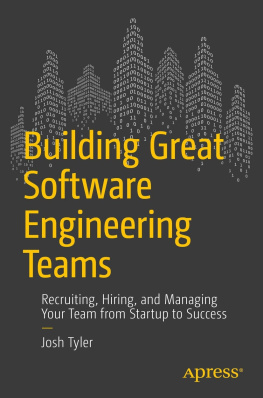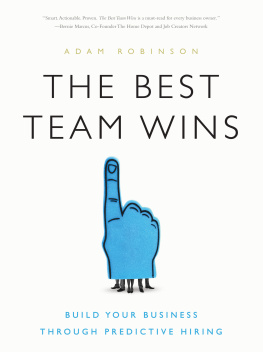
HOW TO RECRUIT AND HIRE GREAT SOFTWARE ENGINEERS
BUILDING A CRACK DEVELOPMENT TEAM

Patrick McCuller

How to Recruit and Hire Great Software Engineers: Building a Crack Development Team
Copyright 2012 by Patrick McCuller
All rights reserved. No part of this work may be reproduced or transmitted in any form or by any means, electronic or mechanical, including photocopying, recording, or by any information storage or retrieval system, without the prior written permission of the copyright owner and the publisher.
ISBN-13 (pbk): 978-1-4302-4917-7
ISBN-13 (electronic): 978-1-4302-4918-4
Trademarked names may appear in this book. Rather than use a trademark symbol with every occurrence of a trademarked name, we use the names only in an editorial fashion and to the benefit of the trademark owner, with no intention of infringement of the trademark.
President and Publisher: Paul Manning
Acquisitions Editor: Jeff Olson
Developmental Editor: Robert Hutchinson
Editorial Board: Steve Anglin, Mark Beckner, Ewan Buckingham, Gary Cornell, Louise Corrigan, Morgan Ertel, Jonathan Gennick, Jonathan Hassell, Robert Hutchinson, Michelle Lowman, James Markham, Matthew Moodie, Jeff Olson, Jeffrey Pepper, Douglas Pundick, Ben Renow-Clarke, Dominic Shakeshaft, Gwenan Spearing, Matt Wade, Tom Welsh
Coordinating Editor: Rita Fernando
Copy Editor: Laura Poole
Compositor: SPi Global
Indexer: SPi Global
Cover Designer: Anna Ishchenko
Distributed to the book trade worldwide by Springer-Verlag New York, Inc., 233 Spring Street, 6th Floor, New York, NY 10013. Phone 1-800-SPRINGER, fax 201-348- 4505, e-mail orders-ny@springer-sbm.com , or visit www.springeronline.com .
For information on translations, please contact us by e-mail at info@apress.com , or visit www.apress.com .
Apress and friends of ED books may be purchased in bulk for academic, corporate, or promotional use. eBook versions and licenses are also available for most titles. For more information, reference our Special Bulk SaleseBook Licensing web page at www.apress.com/bulk-sales . To place an order, email your request to support@apress.com
The information in this book is distributed on an as is basis, without warranty. Although every precaution has been taken in the preparation of this work, neither the author(s) nor Apress shall have any liability to any person or entity with respect to any loss or damage caused or alleged to be caused directly or indirectly by the information contained in this work.
To Zeno of Elea, who has taught us to question our assumptions for twenty-four centuries and counting
Contents
Foreword
To succeed with software, you need a great team. Not just goodgreat.
So what does great mean? Smart. Focused. Team-oriented, but with a healthy ego and drive. Excellent at both deconstruction and synthesis. A sense of humor. Thats just my starting listyours may be different. No matter what is on your list, youre going to be spending a lot of time with these people. Many people spend more time with their coworkers than with their spouses.
Given the stakes involved, you owe it to yourself to get really good at putting teams together. You will succeed either as a team or not at all.
Lets be clearsometimes you need to trust your gut. If youve been hiring people for a long time, you probably have a bag of tricks for evaluating people. The challenge is for that to not be the end of the game. You may have forgotten why you do the things you do. You may not be able to explain it.
If you are new to hiring, you dont even have that gut feeling to rely on youre just winging it. Asking senior managers for advice that boils down to instincts can be worse than useless.
Thats where this book comes in. It breaks down the process of hiring into a structuresomething more useful, a full methodology. If you havent done a lot of hiring, it works as a handbook. If you have done a lot of hiring, it will explain the why behind a lot of the little thingsand fills in a lot of the kind of gaps that come from ad hoc learning.
Theres a great chart in the first chapter. It describes the kinds of challenges you may be having, and you can jump right to the section that discusses solutions. In the book itself, youll find detailed pipeline diagrams, advice on streamlining the process, interviewing, closing, and more.
Most important, you can start to build a culture around how you hire. You can explain it to your recruiters, your manager, and your team. You can move from a hazy, fuzzy, wing it model to one of consistent excellence.
Thats how you succeed.
Will Iverson
Chief Technology Officer
Dynacron Group
About the Author

Patrick McCuller is a software development manager in Seattle, Washington, with eighteen years of engineering and engineering management experience. As an engineer at Microsoft, Sony, and many other companies, and as a development manager at Amazon, Live Nation, and Audience Science, he has conducted hundreds of interviews and made a significant number of extraordinary hires. He has spent countless hours analyzing and engineering the hiring processes, and he loves to interview.
Acknowledgments
The ideas in this book were formed over many years through interaction with many brilliant peoplemanagers, peers, reports, candidates, and friendsso many that I cannot record and acknowledge them all. I hope the great majority will understand when I list just a few of the people whose critical conversation, support, intellectual generosity, and isshoukenmei excellence influenced me the most: Mario Adoc, Jonathan Mastin, Ian Bone, Ethan Evans, and Shefali Shukla. In addition, Ian Bone and Will Iverson provided important feedback on an early draft of .
This book would not have been possible without Andrew Pasquale, who taught me by example that I am the one who decides what sort of person I will be. Less importantly, but just as well, he also taught me high school calculus. I am grateful for both.
I am indebted to Magdalena Donea for discussing and helping with virtually every topic in this book and for her indefatigable encouragement.
CHAPTER
Introduction
This chapter describes the audience and scope of this book and suggests how you can use it to recruit the best software engineers available. It explains the central themes: hiring well is a competitive advantage, treat candidates as well as you treat customers, and take an engineering approach to the recruiting and hiring process. This chapter also provides a troubleshooting table to identify the appropriate chapters for answers to the most common and easily articulated questions.
Who Should Read This Book
This book is intended for technical managers who need to hire software engineers to build core software applications. Technical managers at all levels of hiring experience will benefit from this bookfrom absolute beginners looking for a place to start to veterans looking for ways to optimize the hiring process. That includes software development managers, directors, chief technology officers (CTOs), and entrepreneurs.
Next page










